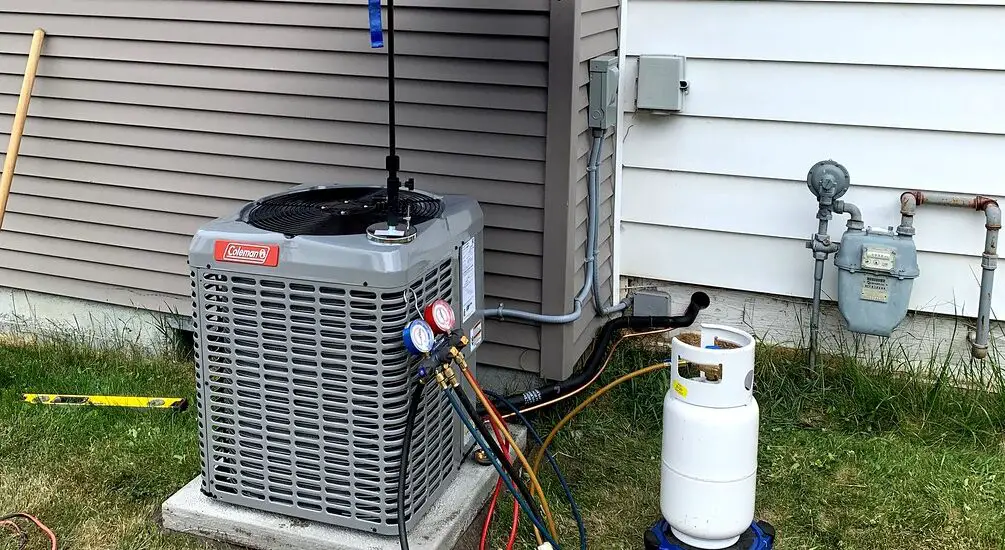Ever sat in a sweltering room, fumbling with the air conditioning remote, only to realize that the problem could be a refrigerant leak in your VRF system? Here’s the scoop: the silent saboteur of your cool, refreshing indoor climate might just be lurking within the intricate mechanics of your cooling setup. We’re talking about VRF refrigerant leak detection, a topic that doesn’t get the limelight it deserves.

This work is licensed under a Creative Commons Attribution 2.0 Generic License.
Table of Contents
Understanding VRF Systems and Refrigerant Leaks
What is a VRF System?
Now, what the heck is a VRF system, you might ask? To put it simply, a Variable Refrigerant Flow (VRF) system is like the superstar of the HVAC world. It’s a sophisticated piece of technology that cleverly regulates the flow of refrigerant to multiple indoor units, ensuring you get your sweet spot of temperature, be it at home or work.
What Causes Refrigerant Leaks in VRF Systems?
So, what exactly triggers these pesky refrigerant leaks in VRF systems? Wear and tear is a biggie. Just like an aging rockstar, VRF systems can start to lose their mojo over time. Throw in improper installation or corrosive elements, and you’ve got yourself a potential leak on your hands.
Importance of Detecting Refrigerant Leaks in VRF Systems
System Efficiency and Performance
Why should you care about refrigerant leaks, anyway? For starters, leaks can take a toll on your VRF system’s efficiency and performance. Imagine trying to run a marathon with a hole in your shoe – doesn’t sound fun, right?
Environmental Impact
And it’s not just about your comfort. These refrigerant leaks aren’t exactly giving Mother Nature a hug. Leaked refrigerants contribute to global warming, and we all know that’s one hug she could do without.
Health and Safety Concerns
But the buck doesn’t stop there. Refrigerant leaks can also be a potential health hazard. Prolonged exposure to some types of refrigerant can lead to things like nausea, headaches, or even asphyxiation in extreme cases. Yikes!
Signs of a Refrigerant Leak in a VRF System
Decreased Cooling Capacity
How can you tell if your VRF system has sprung a leak? One telltale sign is a drop in cooling capacity. If it feels like your AC is blowing more hot air than a politician during election season, you might have a leak on your hands.
Unusual Noises
Another sign? Strange noises. If your VRF system starts to sound like a fussy toddler throwing a tantrum, there might just be a refrigerant leak to blame.
Ice Build-up on Components
Ice on the components of your VRF system can also indicate a leak. It’s like finding your fridge has turned into a winter wonderland – except it’s not as fun, and there’s no Elsa in sight.
To read more in-depth articles: Articles on Refrigerants: The Ultimate Guide to Understanding Them
Techniques for VRF Refrigerant Leak Detection
Electronic Leak Detectors
Time for some tech talk. Electronic leak detectors are a handy tool in the fight against refrigerant leaks. They’re like sniffer dogs for your VRF system, hunting down leaks with precision and efficiency.
Ultraviolet (UV) Dye Leak Detection
Ever used a UV light to check for spills on a hotel bedsheet? (Hopefully not.) Well, UV dye leak detection works on a similar principle. The dye circulates with the refrigerant, and under UV light, any leaks will glow like a neon sign at a dive bar.
Bubble Solution Leak Detection
Bubble solution leak detection is another nifty method. This one’s straightforward as pie – you simply apply the solution to suspected areas, and if there’s a leak, you’ll see bubbles popping up faster than notifications on a teenager’s phone.
Infrared Camera Leak Detection
Then there’s infrared camera leak detection. These cameras are like the super-sleuths of leak detection, spotting trouble with thermal imaging. But remember, they’re not infallible and sometimes require a secondary confirmation method.
Steps to Repair Refrigerant Leaks in VRF Systems
Leak Isolation and Verification
Found a leak? The first step is isolating and verifying the source. It’s like playing a game of hide and seek with your VRF system, except the stakes are way higher.
Leak Repair
Once the leak’s been pinpointed, it’s time for some TLC. Depending on the severity, this could involve brazing or applying leak sealants. It’s like patching up a wound to get your VRF system back in fighting shape.
Post-Repair Testing
After the repair, testing is crucial. It’s the all-clear signal you need to know your VRF system is ready to roll again.
Preventive Measures Against Refrigerant Leaks in VRF Systems
Regular System Maintenance
Prevention, as they say, is better than cure. Regular maintenance is key to keeping those dreaded refrigerant leaks at bay. It’s like taking your car for routine oil changes – just a smart move to keep things running smoothly.
Professional Installation and Service
Don’t underestimate the power of professional installation and service. It’s the difference between a shoddy DIY job and a masterpiece created by a skilled artisan.
Early Leak Detection
Finally, keep an eye out for early leak detection. It’s like catching a small fire before it becomes a raging inferno, saving you a heap of trouble (and money) in the long run.
In conclusion, VRF refrigerant leak detection is a vital part of maintaining an efficient, safe, and environmentally friendly HVAC system. So don’t wait for your next sweltering day or an unexpected ice age in your living room. Get proactive about your maintenance and be a hero for your HVAC system!